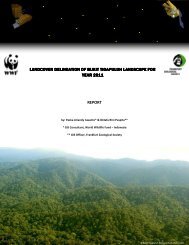The Eastern Himalayas New Species Discoveries
The Eastern Himalayas New Species Discoveries
The Eastern Himalayas New Species Discoveries
You also want an ePaper? Increase the reach of your titles
YUMPU automatically turns print PDFs into web optimized ePapers that Google loves.
<strong>The</strong> <strong>Eastern</strong> <strong>Himalayas</strong> have yielded 16 new reptile species over the past 10<br />
years. <strong>The</strong>se include 13 lizards and three snakes.<br />
<strong>The</strong> most colourful snake discovery has been the emerald green pitviper, Trimeresurus<br />
gumprechti. Officially discovered in 2002 58 , Gumprecht’s green pitviper is venomous and<br />
capable of growing to 130cm in length. Scientists predict that larger specimens exist. <strong>The</strong><br />
species is known to occur around Putao, at altitudes above 400m in the far north of<br />
Myanmar 59 . <strong>The</strong>re are some striking differences between the males and females of this<br />
species; females reach a greater size, with a thin, white or whitish-blue streak on the head, and<br />
deep yellow eyes [7a]; males are shorter, have a red stripe on the head, and bright red or deep<br />
red eyes [7b].<br />
This species is mainly found in rugged, forested areas, often in the vicinity of streams, as well<br />
as bamboo thickets. It also occurs near human settlements and along trails. Mostly nocturnal,<br />
this snake is arboreal, but can also be found on the ground. <strong>The</strong> largest known<br />
specimens were collected while they were resting on branches near a stream. Rodents and<br />
skinks have been recorded as prey, but the species has also been observed killing and eating<br />
other pitvipers of a similar size.<br />
Another nocturnal snake, Zaw’s wolf snake (Lycodon zawi) [7c], was discovered dwelling in<br />
forests and near streams at elevations of less than 500m high in Assam, India, including in the<br />
Garbhange Reserve Forest and in northern Myanmar. <strong>The</strong> black snake, with white bands, can<br />
grow to half a metre in length, and feeds mainly on geckos 60 . <strong>The</strong> find increases the diversity<br />
of the Lycodon genus to four in Myanmar and to five in north east India.<br />
In 1999, a new species of blind snake was officially described from Darjeeling, Assam, near<br />
India’s border with Nepal 61 . Also called the Darjeeling worm snake on account of its<br />
appearance, Typhlops meszoeyli [7d] was discovered in the forest-covered foothills of the<br />
<strong>Himalayas</strong>. As the name suggests, the snake’s eyes and body are covered by smooth shiny<br />
scales, a sign of its adaptation to a subterranean life, allowing it to move easily through earth.<br />
<strong>The</strong> snake feeds mainly on the eggs and larvae of termites and ants, and can occasionally be<br />
found high in trees, having reached these heights by using termite galleries. Typhlops meszoeyli<br />
belongs to super family Typhlopidae, which comprises more than 200 different blind<br />
snake species world-wide.<br />
According to scientists, several new species of reptiles still await description 62 , including a<br />
new species of pitviper caught after a one-year hunt in the rainforests of north-east India. <strong>The</strong><br />
new species can measure longer than two metres and is already the stuff of local legend.<br />
“Barta”, as the snake is known by the local Nyishi tribesmen, is the most-feared creature<br />
among the tribes in Arunachal Pradesh. According to Nyishi folklore, sighting of a barta,<br />
meaning the deadliest of all snakes, is a very bad omen 63 .<br />
A 100 million-year-old gecko<br />
Perhaps the most fascinating and globally significant new reptile<br />
species discovery over the past 10 years is one that is not ‘new’ in<br />
the classic sense. Cretaceogekko burmae, a 100 million-year-old<br />
gecko [7e], the oldest fossil gecko species known to science, was<br />
discovered in an amber mine excavated in the Hukawng Valley in<br />
the Himalayan region of far north Myanmar 64 . Originally baffling<br />
scientists, who were unable to assign the gecko preserved in amber<br />
to any known taxon, they officially described the species and genus<br />
as entirely new in 2008.<br />
<strong>The</strong> species discovery is significant, as it transformed the existing<br />
understanding about the origin of geckos. Because the species has<br />
the foot proportions and adhesive toe pads found in modern geckos,<br />
the discovery provided evidence that modern geckos had already<br />
evolved 100 million years ago. <strong>The</strong> specimen is tiny, even when<br />
compared with hatchlings of the smallest geckos living today.<br />
However, the high numbers of lamellae on its toe pads suggest it<br />
is from a species with a relatively large adult body size. <strong>The</strong> find<br />
even surprised the scientific community. Cretaceous amber from<br />
Myanmar includes a plethora of plant and invertebrate remains but<br />
vertebrate fossils are very rare 65 . Further new amber discoveries<br />
include a termite that has intestinal protozoa [7f], showing the<br />
oldest example of mutualism; the oldest known mushroom [7g]; the<br />
oldest described tick; and the oldest fern in amber [7h].<br />
© George Poinar<br />
7e<br />
Cretaceogekko burmae<br />
7f<br />
7g<br />
7h<br />
© George Poinar<br />
© George Poinar<br />
© George Poinar<br />
18

















